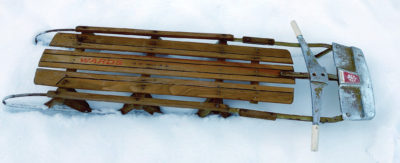
Dorri Partain
Northeast News
The kids will be dashing through the snow (next time the white stuff hits town) if Santa left a sled under the tree, creating years of winter fun memories.
The sled, whether the runners were wooden or metal, has been used since ancient times to carry people and goods across snow or sand-covered terrain.
Using a sled for recreational purposes, often called “coasting,” became a popular pastime for children and adults alike in the mid-1800s.
Paris Hill Manufacturing Co., founded by Henry F. Morton in 1861, started as a home-based business that produced one sled at a time.
Morton’s wife Lucilla painted the sleds that he crafted from wood in their kitchen.
By 1869, demand became great enough they built a factory in their hometown of Paris Hill, Maine.
While popular, downhill coasting could also be dangerous because the sled had no steering mechanism to avoid approaching objects, such as rocks, trees, or other sleds.
Samuel Leeds Allen, a manufacturer and inventor of farm implements, needed a product to keep his production line operating year-round.
Dubbed “The Flexible Flyer,” Leeds received U.S. Patent 408,681 on August 13, 1889 and began manufacturing his new and improved version.
By 1900, the Flexible Flyer had become the most popular brand of sled, and other sled companies began creating their own versions with steering mechanisms.
Retailer Montgomery Wards version, shown here, carried the Hawthorne label.
As listed in the 1968 Christmas catalog, the Deluxe model’s “Y-type steering bar and sure hold hand grips assure easier control on turns and curves” and featured “spiral wood grips for easier carrying.”
Available in four different sizes, the largest (58 inches) sold for $12.88 and could be steered with the hands if lying down or the feet if sitting up.
Since 1978, the Flexible Flyer has been manufactured by Paricon, owned by the great-grandchildren of Henry Morton.
Montgomery Wards, which had a huge presence here in the Historic Northeast, went out of business in 2001.



















